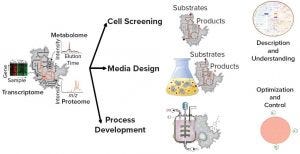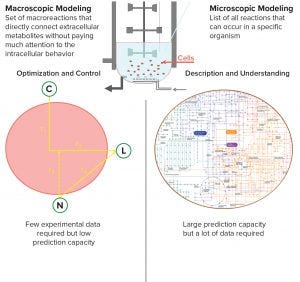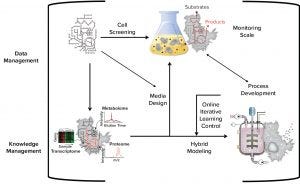From Big Data to Precise Understanding: The Quest for Meaningful InformationFrom Big Data to Precise Understanding: The Quest for Meaningful Information

Figure 1: Systems biology tools can facilitate upstream research activities (bioreactor imagery: https://commons.wikimedia.org/wiki/User:Rocket000/ SVGs/Chemistry#/media/File:Bioreactor_principle.svg).
High-throughput technologies have transformed the biotechnology industry. The amount of data they generate is at least a hundred times higher now than it was two decades ago, primarily because of the rise of “-omic” technologies. As in many other industries, the biopharmaceutical sector entered the era of big data the day that high-throughput analytics were routinely implemented in experimental research.
Big data refers to “datasets with sizes beyond the ability of commonly used software tools to capture, curate, manage, and process data within a tolerable elapsed time” (1). Technically, scientists from the field agree that big data is defined by specific attributes, the so-called 4V model: volume (scale of data), variety (different forms of data), velocity (analysis of streaming data), and veracity (uncertainty of data) (2). Considering these definitions, is the size of the datasets that biopharmaceutical researchers handle truly the problem?
Compared with other research sectors, the biopharmaceutical industry generates low amounts of data. That is mainly because of the costs associated with experimental procedures for producing good-quality data, but also because the industry’s conservative mindset restricts dataset use to proprietary generators. Thus, experiments established in the context of a biopharmaceutical project rarely are big data.
The size of datasets might begin to be a problem if data across projects or across the industry were considered together. However, even if the intellectual propriety burden of sharing bioprocessing data is assuaged, such databases are not easily accessible in machine-readable format. Furthermore, the lack of standardization among such databases makes them difficult to exploit systematically without extensive processing. Unfortunately, that statement is many times also valid for data generated by different research teams within one company because their data can be corrupted by the heterogenous environment (3) and potential hidden factors (4).
Although data have been generated for decades in the biopharmaceutical sector, the precarity of data management solutions in many companies renders exploitation of those data almost impossible. This consideration of historical bioprocess data also raises the question of data “longevity.” Indeed, data support and experimental techniques are evolving continuously, making it difficult to extract data from obsolete storage supports (e.g., floppy disks) and to compare data generated using different generations of experimental technologies — such as serial analysis of gene expression (SAGE) compared with RNA sequencing (RNAseq). Thus, the main problem with biopharmaceutical datasets is not related to their size but more likely to the time researchers require to handle those data, including integration of diverse data sources and extraction of meaningful information from such integrated datasets.
Machine Learning As a Discovery Driver for Large Datasets
Machine learning (ML) is a powerful tool that helps researchers extract information from data (5). ML is expected to be a significant tool in the bioprocess industry (6). Over the past few years, biomanufacturers have invested greatly in the development of such data-driven methods and in data capturing and management solutions.
Increasing attention to those approaches has led to researchers questioning the ability of large datasets to “speak for themselves” (7). Many researchers have demonstrated that “big structure” is full of spurious correlations because of noncausal coincidences, hidden factors, and the nature of “big randomness.” With a deluge of new ML tools, some researchers point to the complexity of algorithms developed, making it impossible to inspect all parameters or to reason fully about how inputs have been manipulated (8).
Although we can highlight only the invaluable potential impact of such techniques, it is important to keep in mind that ML tools also can turn out to be “fool’s gold.” Specifically in biotechnology, black-box approaches will support rapid development of powerful predictive models if a problem is concise and well structured. But their ability to provide biologically relevant explanations of predicted results from a given dataset might be somewhat compromised. To prevent such pitfalls, the empirical knowledge that has been accumulated over decades of biological research should be integrated as a baseline to guide such data-driven methods.
Systems Biology Tools: Beyond Drug Discovery and Cell Design
Systems biology tools are model-based approaches used for the description of complex biological systems. They enable the coherent organization of large datasets into biological networks, and they provide insights on biological systems that in vivo experiments alone cannot (9). In the context of metabolic processes, genome-scale metabolic network models (GEMs) are used as platforms for -omics data integration and interpretation by linking the genotype of an organism and the phenotypes it can exhibit during an experiment. Such networks can be used as libraries for developing cell- and tissue-specific models. Because some enzymes are active only in specific environments, context-specific extraction methods can be used for tailoring genome-scale models based on -omic data integration. Several algorithms have been developed to recapitulate the metabolism of specific cell and tissue types, providing useful insights into their metabolism under such specific conditions (10). Biological networks then can be used as frameworks to integrate diverse data sources and subsequently extract meaningful information. So a GEM can be described as not only a network of reactions, but also as an interconnected map of cellular functions.
Systems biology tools have proven to be invaluable at the level of preclinical research such as for designing new drugs by informing upon target selection (11) or for engineering cells by rewiring their metabolism toward the production of a product (12). But such approaches can be used for much more. For example, they could be applied at the industrial level in the field of upstream activities, including process design, monitoring and control, lowering experimental effort, and increasing process robustness and intensity (Figure 1). Such efforts are expected to facilitate greatly the implementation of the quality by design (QbD) paradigm and process analytical technology (PAT) initiatives. Based on the potential predictive power of such mechanistic approaches, you might be surprised that improved bioprocess performance still is achieved mainly by semiempirical media and bioprocess optimization techniques (e.g., media screening and statistical design of experiments, DoE).

Figure 2: Macroscopic and microscopic modeling
Current restricted applications of such systems-biology tools are caused by the lack of a systemic workflow to generate predictive models for upstream activities from biological networks. The complexity and structure of predictive mechanistic models mainly are defined by their final purposes (13) (Figure 2). A model with the objective of describing as accurately as possible the mechanisms underlying a process operation certainly will have a greater structural complexity than a model developed for optimization of that process. It is important to note that the dynamics related to a process operation can vary in complexity themselves. Obviously, it is much easier to model the operation of a draining sink than to model the operation of a combustion engine, for example. So one part of a model’s structural complexity also will mirror the complexity of the system being studied.
Next Generation of Upstream Activities Management
In principle, faster process development can be established in different ways. However, considering cost constraints, it is implied that no more personnel will be used to accomplish more work, regardless of the selected approach. Common guidelines could be used to meet that challenge and can be implemented through three main development panels:
data generation and management
process and product behavior understanding
use of transferable platforms and automation.
Process development and optimization greatly rely on generation of experimental data. Clearly, knowledge management is now and increasingly will be the decisive element for efficient process development. For companies to benefit from increased throughput, experiments must be carried out in a structured way, and data generated must be stored properly in one place to be used correctly for process understanding and improvement (14).
Data should be easily retrievable and contextualized such that results from different sources can be related and compared easily. Knowledge that is captured in reports also needs to be accessible easily. Search algorithms could help biopharmaceutical scientists and researchers find relevant information in dedicated file services. However, the conversion process from data to hypothesis testing is long and tedious. For example, the “digestion” of data or information from reports to the formulation of a new hypothesis for experimental testing that hypothesis might not be the most efficient approach to extract meaningful knowledge.
To overcome that, collected data can be overlaid upon biological networks, enabling description of cellular mechanisms and identification of metabolic drivers behind observed phenotypes. Those mechanistic networks also can be used to assess the impact of process choices on product attributes, enabling rational process optimization (e.g., achievement of a robust process while achieving maximum yield). However, because of missing information (e.g., the mechanisms of action are not understood or inadequate resolution of analytical capabilities), the complete mechanistic description of an entire biological production process is far from an easy task. To overcome such limitations, mechanistic approaches need to be used with data-driven models (ML tools) as hybrid (semiparametric) modeling approaches (15).

Figure 3: Integrated workflow for upstream activities management (bioreactor imagery: https://commons.wikimedia.org/wiki/User:Rocket000/ SVGs/Chemistry#/media/File:Bioreactor_principle.svg)
To reduce experimental repetition at large scales and continuously improve a process, developers need to understand how the effects of the phenomena change with scale. That can be established either by developing representative experimental scale-down models that mimic process behavior at large scales (16) or by using mathematical models such as computational fluid dynamics (17, 18). Such transferability of knowledge and understanding is important not only between scales, but also from project to project. Platform processes formats can help to this end because they allow (at least to some degree) reuse of developed understanding. Combining platform process formats with developed hybrid mathematical models will enable the transfer of knowledge between projects and from development to manufacturing (Figure 3).
Rather than redeveloping models for each application/project/case, biopharmaceutical scientists should aim for the development and maintenance of a common-core model. That model then would be updated automatically whenever new knowledge and data become available. The common-core model also could be exploited directly to suggest which next experiment might offer the greatest insight (e.g., optimal experiment design, model-based experiment design, or active learning) or to deliver the most desired process properties and performance (e.g., batch-to-batch process optimization, run-to-run process optimization). Thus, you ensure that the same error is not repeated and that you make the most efficient use of existing knowledge.
Acknowledgments
AR and MVS wrote and edited the manuscript. Both authors were involved in drafting the content and structure of the manuscript and approved the final version. Development of this article was sponsored by GlaxoSmithKline Biologicals SA. The authors declare the following interest: AR and MVS are employees of the GSK group of companies. MVS is cofounder of Novasign GmbH.
References
1 Big Data. Wikipedia; https://en.wikipedia.org/wiki/Big_data.
2 The Four V’s of Big Data. IBM, 2013; http://www.ibmbigdatahub.com/infographic/four-vs-big-data.
3 Bühlmann P, van de Geer S. Statistics for Big Data: A Perspective. Stat. Prob. Lett. 136, 2018:37-41; doi:10.1016/j.spl.2018. 02.016.
4 Liu Y, et al. Multiomic Measurements of Heterogeneity in HeLa Cells Across Laboratories. Nat. Biotechnol. 37, 2019: 314–322; doi:10.1038/s41587-019-0037-y.
5 Witten IH, et al. Data Mining: Practical Machine Learning Tools and Techniques, 4th ed. Morgan Kaufmann Publishers Inc: Cambridge, MA, 2016.
6 Manyika J, et al. Big Data: The Next Frontier for Innovation, Competition, and Productivity. McKinsey Global Institute: New York, NY, 2011.
7 Calude CS, Longo G. The Deluge of Spurious Correlations in Big Data. Found. Sci. 22(3) 2016: 595–612.
8 Riley P. Three Pitfalls to Avoid in Machine Learning. Nature 572(7767) 2019: 27–29.
9 Bordbar, et al. Constraint-Based Models Predict Metabolic and Associated Cellular Functions. Nat. Rev. Gen. 15(2) 2014: 107–120; doi:10.1038/nrg3643.
10 Opdam S, et al. A Systematic Evaluation of Methods for Tailoring Genome-Scale Metabolic Models. Cell Sys. 4(3) 2017: 318–329; doi:10.1016/j.cels.2017.01.010.
11 Schmidt BJ, Papin JA, Musante CJ. Mechanistic Systems Modeling to Guide Drug Discovery and Development. Drug Discovery Today 18(3–4) 2013: 116–127.
12 Mardinoglu A, et al. Genome-Scale Metabolic Modelling of Hepatocytes Reveals Serine Deficiency in Patients with Nonalcoholic Fatty Liver Disease. Nat. Commun. 5, 2014: 3083.
13 Walter E, Pronzato L. Identification of Parametric Models from Experimental Data. Springer: London, 1997.
14 Sadowski MI, Grant C, Fell TS. Harnessing QbD, Programming Languages, and Automation for Reproducible Biology. Trends Biotechnol. 34(3) 2016: 214–227.
15 Narayanan H, et al. Bioprocessing in the Digital Age: The Role of Process Models. Biotechnol. J. e190017, 2019; doi:10.1002/biot.201900172.
16 Neubauer P, Junne S. Scale-Down Simulators for Metabolic Analysis of Large-Scale Bioprocesses. Current Op. Biotechnol. 21(1) 2010: 114–121.
17 Anane E, et al. Modelling Concentrations Gradients in Fed-Batch Cultivations of E. coli: Towards the Flexible Design of Scale-Down Experiments. J. Chem.Technol. Biotechnol. 94, 2018: 516–526.
18 Bach C, et al. Evaluation of Mixing and Mass Transfer in a Stirred Pilot Scale Bioreactor Utilizing CFD. Chem. Eng. Sci. 171, 2017: 19–26; doi:10.1016/j.ces.2017.05.001.
Corresponding author Anne Richelle ([email protected]) is senior specialist (metabolic modeling), and Moritz von Stosch is senior manager (fermentation) and lead, both at the Process Systems Biology and Engineering Center of Excellence at GSK, Rixensart, Belgium.
You May Also Like





